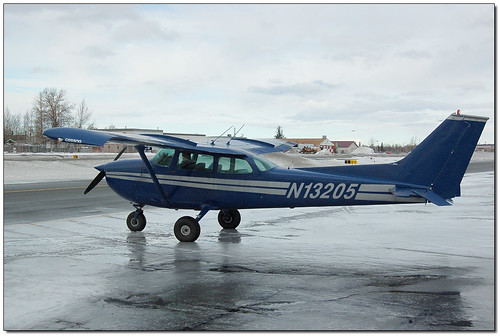Aircraft: C172 N13205
Flight Time: 1.2 hours
Total Hours: 3.8
We had to wait a couple hours for the thick layer of ice fog to burn off around the airfield, but when it did, we were rewarded with an incredible clear afternoon. All of the mountains were out, and once in the air, we had an awesome view of the Denali, Foraker and Mt. Hunter, off to the northwest. Outside air temperature hovered around 15 degrees and a thin layer of rhyme ice covered all the trees.
I flew a different plane today, N13205, a 1973 Cessna 172M, blue with white numbers.
This particular plane has as STOL kit (short takeoff and landing) stall strips on the wing, and big tires. The cockpit controls are a bit different, which is probably a good thing to get used to early on.
After completing the preflight checklist in the hangar, we rolled the plane outside, started her up, and after obtaining ATIS info and clearance to taxi over to runway 25, we took off. I should say, I took off, because I don’t think that Mark even had his hands on the yoke. Still getting used to steering the plane on the ground, since it’s the rudders that do all the work- the yoke doesn’t have any affect at slow speeds.
Once in the air, we climbed over the city and turned our way over to the practice area. On our way across the Knik Arm, we saw a huge cargo jet coming in from the west. It had been on its way to Elemendorf, but since we were in its path, it broke off its approach pattern and circled back around.
Mark demonstrated power-on and power-off stalls. The power-off stalls are certainly more dramatic, when the plane reaches critical low airspeed, the stall horn sounds and the plane simply begins to drop. Recovering is straightforward, you just add power and bring the nose back to level.
I also got some “hood time.” I’m required to have 3 hours of flying by instrument reference, to simulate what may happen if I find myself flying into a cloud. Mark had me wear a special pair of oversized bifocal glasses that are clear on the bottom and opaque on the top. They allow you to see the instruments in the cockpit, but not out the window. Without visual reference, Mark had me fly straight headings and perform a series of turns, climbs and descents soley by instrument reference.
On our way back, during our final approach, I had a total bonehead moment. We entered the pattern, but when we made our turn to final, I was surprised to see runway 25 right in front of us. I had been used to coming and going on runway 7, and even though we had gotten the ATIS that indicated that runway 25 was active, somehow, I was still thinking 7 and got mixed up. We came in too high and I did my first go around.
I also got my introduction to crosswind landings. The wind was definitely blowing us to the side as we came in on final approach, so Mark demonstrated the rudder and aileron technique for bringing the airplane down in crosswind situations. What made it even more exciting was the snow that covered the runway.
Even though I had a space-out moment with the approach, I felt good about my progress during this lesson. I did a much better job handling the plane, even in the bumpy wind up high. I also felt pretty good in the pattern. Coming down towards the runway on final still happens pretty fast, but I’m getting more comfortable controlling my turns and airspeed throughout the rest of the pattern legs. Mark assures me that I’m doing well and that the landing part will just take time and more practice. Also, I enjoyed flying N13205, it handles differently and I look forward to taking it up again in my next lesson.


Fun read, Dan.
I learned to fly at Merrill Field when I was a teen. Although I no longer fly (a prioritization of resources, you might say), I miss it daily. I can still close my eyes and easily visualize every aspect of the experience.
If you’re willing, I’d love to meet you at one of your lessons to get a few pictures of you pre-flighting your plane. I think it would be great fun to have a single picture showing you in multiple locations around the plane…the thorough pilot preflighting his aircraft, you might say.
Bob